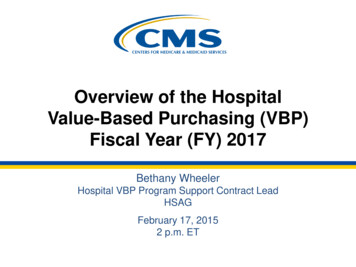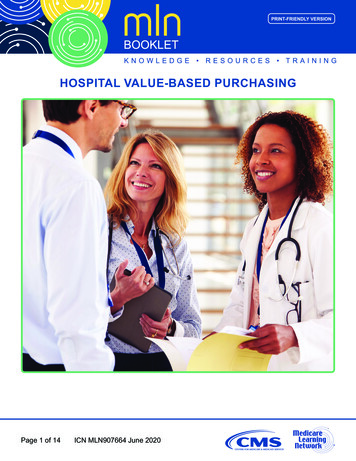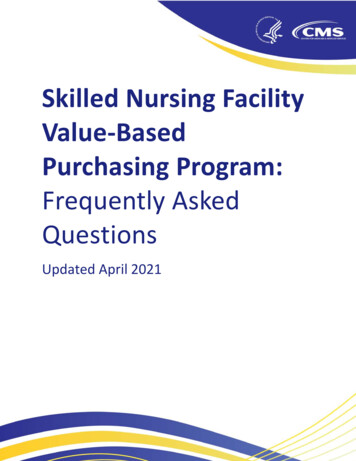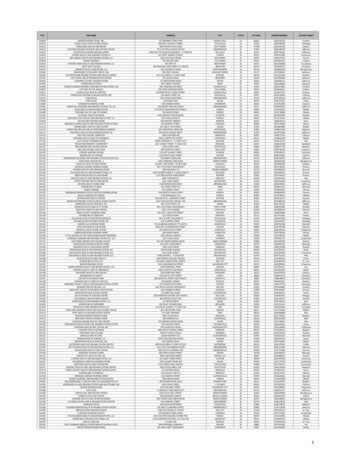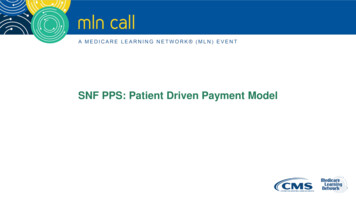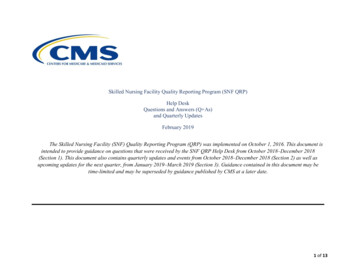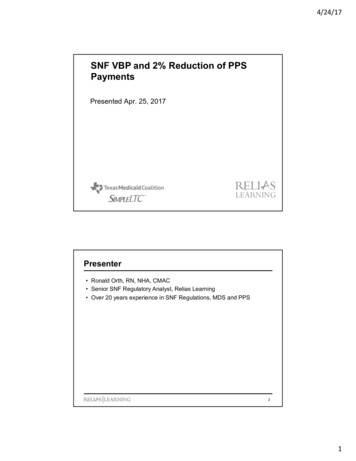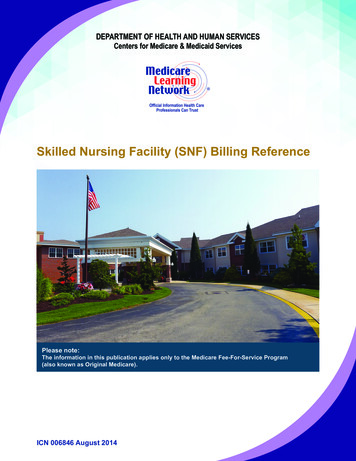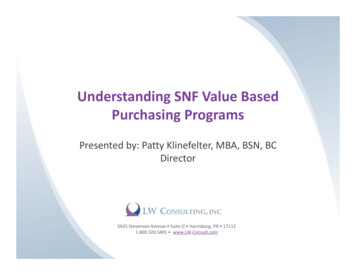
Transcription
Understanding SNF Value BasedPurchasing ProgramsPresented by: Patty Klinefelter, MBA, BSN, BCDirector5925 Stevenson Avenue Suite G Harrisburg, PA 171121.800.320.5401 www.LW-Consult.com
Objectives Describe the SNF Value-Based Purchasing ProgramUnderstand which SNF are included in the SNF VBP programState the measure used in the programExplain how the performance scores will be calculatedNote the time period of the programKnow the process for reviewing and correcting data used incalculating the incentiveDevelop strategies for improving readmissionsDiscuss how telehealth can improve readmissions
SNF PPS Final Rule Key Points Effective 10/1/18 Value Based Purchasing Program Quality Reporting Program Penalties Medicare payment rates increase by 2.4% The revised case-mix methodology is called: Patient-Driven Payment Model (PDPM) Effective October 1, 2019
SNF VBP Program Builds on previous quality measures Rewards SNF with incentive paymentfor quality care Pays providers based on the quality,rather than the quantity, of care theygive patients. Started Oct 1, 2018
Protecting Access to Medicare Act of 2014 Program requirements include: Readmission quality measure Performance standards Scores publicly ranked from low tohigh 2% of SNFs’ Medicare paymentswithheld Incentive payments No volume exclusions Confidential reporting
SNFs Included in VBP All SNFs paid underthe ProspectivePayment System Include freestandingSNFs, SNFs associatedwith acute carefacilities, and all noncritical access hospital(CAH) swing bed ruralfacilities.
SNFRM Readmission Measure Medicare Fee-For-Service Part A Claims for inpatients at PPS, criticalaccess, or psychiatric hospitals Readmissions within 30-day window from hospital discharge any causeor condition During and after SNF stay Hospital readmissions not SNF readmissions Risk-adjusted Excludes planned readmissions and observation stays The SNFRM will be in use for the FY 2019, 20 & 21
SNFPPR 30 day potentially preventable inpatient readmission measure In the FY 2017 SNF PPS final rule, the second measure The SNFPPR assesses the risk-standardized rate of unplanned,potentially preventable readmissions (PPRs) from a priorhospitalization Propose to replace the SNFRM with the SNFPPR in futurerulemaking
SNFRM Risk Adjusted Patient demographicsPrincipal diagnosis in the prior hospitalizationComorbid conditionsDisability as the original reason for MedicarecoverageHealth service tivesPatient-Assessment- .html.
Planned vs Unplanned Readmission Algorithm to IDplanned readmissions Specific list of procedures oradmitting DX If planned procedure occurs incombination with DX thatdisqualifies from being plannedthen will be consideredunplanned Claims based measure noadditional data to be submitted
Exclusions An intervening post-acute care admission within the 30-day measurewindow More than 1 day between the prior proximal hospital discharge and theSNF admission Discharged from the SNF against medical advice The principal diagnosis from the prior hospitalization was medicalnonsurgical treatment of cancer, rehabilitations services or prothesisfittings
Special Exceptions Low volume SNFs 25 eligible stays neutral incentive multiplier New SNFs Zero eligible stays during baseline and performanceperiods neutral incentive multiplierMissing Baseline PeriodZero eligible stays during baseline but 25 duringperformance period score based only on achievement Extraordinary CircumstancesNatural or manmade disasters if approved period of timeexcluded form counting RM rate
SNF VBP Program 60% of the 2% held will beredistributed Baseline year 2015 Performance year 2017 Improvement score Achievement score Higher will equal performancescore
Scoring Achievement scorecompares to SNFsnationally Improvement scorehow SNFs compare toown baseline
2015 Performance Standards 25th percentile 20.41% Achievement Threshold 79.59% Mean of best decile 16.40% Benchmark 84.60%
Achievement Score Performance period (CY 2017) with the performance of allfacilities nationally during the baseline period (CY 2015) Rate benchmark (84.6%) RM Rate 16.4%:100 points Rate achievement threshold (79.59%) RM rate 20.4%:0 points Rate between the two: 1 – 99 points 40% SNF rate lower under VBP then before VBP
Improvement Score Comparing the facility’s rate during theperformance period (CY 2017) with its previousperformance during the baseline period (CY 2015) Rate better than or equal 16.4%: 90 points If readmission rate for CY 2017 CY 2015: 0 points Rate between the two: 1 – 89 points
Performance Scores Scored based on performanceduring the applicable baselineperiod and performance period Higher of the Achievement orImprovements score Performance Period CY 2017 Baseline Period CY 2015
Payment Score payment Simultaneously all SNF reduced by 2% Increased up to 3.65 based on your performance score – national rankingNet impact -2% - 1.65%Assigned an incentive payment multiplierApplies to all claims Oct 1 2018 - Sept 2019New multiplier each year
Incentive Payment Multiplier The IPM is applied directly to your facility'sadjusted federal per diem rate on each claimat step three from above. It is NOT applied after a 2% cut as it alreadycontains the cut. An IPM of 1.00000 means you will NOT see acut, an IPM 1 means you will see a paymentincrease, and an IPM of 1 means you willsee a cut.
Nursing Home Compare SNF performance data for thebaseline year CY 2015 is nowpublicly available via NursingHome Compare Provide provider number, nameof facility, address and 2015 CY,baseline year, readmissionpercent Aggregate 19.002
Nursing Home CompareCARILION TAZEWELL COMMUNITY HOSPITAL18.995SOUTH ROANOKE NURSING HOME INC17.087MANORCARE HEALTH SERVICES-ALEXANDRIA18.065RICHFIELD RECOVERY & CARE CENT18.678ROMAN EAGLE REHABILITATION AND HEALTH CARE CENTER22.219WOODBINE REHABILITATION & HEALTHCARE CENTER20.704KENDAL AT LEXINGTON18.719MANASSAS HEALTH AND REHAB CENTERMANORCARE HEALTH SERVICES-RICHMOND18.39920.711OAKWOOD MANOR BEDFORD MEM15.586GOODWIN HOUSE ALEXANDRIA18.128SIGNATURE HEALTHCARE OF NORFOLK18.061THE GARDENS AT WARWICK FOREST18.683HEARTLAND HEALTH CARE CENTER - LYNCHBURG18.228HEALTH CARE CENTER LUCY CORR17.576RIVER VIEW ON THE APPOMATTOX HEALTH & REHAB CENTER19.311KINDRED TCC AND REHABILITATION-BAY POINTE19.313SALEM HEALTH & REHABILITATION16.499FRIENDSHIP HEALTH AND REHAB CENTER18.571
Nursing Home Compare List of SNFs included in FY 2019 SNF VBP ProgramIncentive payment multipliersRankings15,306 SNFs5,230 unique rankingsSNFs with the best performance appear at the top of thelist and SNFs with tied rankings are ordered by CMSCertification Number (CCN)Range of multipliers 0.9802457176 to 1.0164677296
Ranking of 552081.01628896214506762561.0162823210451
Quarterly Confidential Feedback Reports Quarterly confidentialreports Quality ImprovementEvaluation System(QIES) and CASPER help@qtso.com.
Performance Score Report Contents Cover Sheet Eligible Stays Facility Level Data Dictionary
Tab 1 Cover Sheet Performance period: CY2017 Baseline Period: CY2015 Provider name andnumber
Tab 2 Eligible Stays Complete list of stays Patients admitted 1/17 – 12/17 Submit corrections 3/31/2019 SNFVBPinquiries@cms.hhs.govmailbox Don’t email PHI
Tab 2 Eligible Stays Hospital data (claims) DC date Readmitted in 30 days Planned vs unplanned Patient characteristics usedto risk adjust
Tab 3 Facility Performance Achievement score Improvement score Performance score VBP Program rank Incentive payment multiplier
Tab 4 Data Dictionary Descriptions Definitions Help understand report
Payment Adjustments Payment adjustments aremade in the order of: 1) Market basketadjustment 2) QRP adjustment (ifany) 3) VBP adjustment 4) Sequestration
Strategies Know and understand your data Who, when, diagnosis, why, MD, dayof the week, post d/c SNF Ask patient, family, ACF casemanagers, ED staff, SNF staff floornurse, aide, therapist, management Review chart
Nursing Home Study47 Nursing Home in New York26,746 ResidentsThree strongest predictors1.2.3.Nursing communication with physiciansMD treat residents in nursing home, hospitalization lastresortImproved training for nurses and NA related to end of lifecareYoung Y et al. Clinical and nonclinical Factors associated with potential avoidable hospitalizations among nursing home residents in NYS. JAMDA 2011;12:364 - 371
American Health Care AssociationLower Rehospitalization Rates1. Use all components of Interact program2. Understand resident's wishes and goals havediscussions related to end of life care3. Track hospitalization rates4. Conduct root cause analysis5. Perform risk assessment related to rehospitalization6. Coordinate care post SNF7. Improve nurse to MD communicationAmerican Health Care Association Improving Lives by Delivering Solutions for Quality Care Presentation by David Gifford, MD MPH
Strategies Depending on whatdata tells Better handoffs Disease specificprograms Provider availability
TelehealthEstablish Telehealth goals Provider availabilityReadmission rateReferrals readmission rateLosing referrals to competitorsQuality publicly reportedoutcomes Transportation costs Staffing Resident/family satisfaction
Staff Senior level engagement andsupport Engage Medical Directors andfront line staff Educate Champion Reach out to colleagues use theirexperiences
Residents Served Demographic Population Payer
Research Reimbursement Licensure options Different TH equipmentiPadKioskBP cuffsCameraEKG
Budget Establish budget Develop long term financialplan Equipment Maintenance Staff/Providers
Vendors Prior to on-site evaluationdevelop tool to use inselection process Evaluate and select vendorby team including nurses,physicians and leadership Work with vendors onimplementation table
Develop Compliant policies andprocedures Define operationalsteps Billing process if able Marketing messages
Timeline Develop project plan Realistic timeframes Determine tasks Assign responsible parties Revisit on regular basis
ScorecardBased on goalsDetermine what to measure and whyWhen to measureWho and how to measureKey metrics number of TH visits, MDs, patient types,reimbursable, readmissions, transportation costs, newadmissions
ROIBased on goals Reduced readmissions Transportation costs Admissions newrevenue
ROI Residentsatisfaction/retention Access to specialists Rural coverage Provider satisfaction
Telehealth InformationMGMA Stat poll 40% of medical groups stated they are planningto offer TH this yearAmerican Well/Harris Poll Survey nearly 2/3 patients would likePCP to offer THReach Health 2017 U.S. Telemedicine Industry Benchmark Surveyreimbursement and EMR systems pose two impediments2017 Telemedicine and Digital Health Survey ¾ offer or plan tooffer TH
SuccessesUniversity of Pittsburg Medical Center since Nov 2015avoided 140 transfer from SNF to ACF with a costsavings of 400,000Curavi Raven (CMS funded grant)25.9% reduction in all cause hospitalization27.8% potentially avoidable hospitalizations40% potentially avoidable ED visits*RTI Year 3 Report - icine-technology
Success American Journal ofManaged Care (AJMC) 365bed Cobble Hill HealthCenter in Brooklyn, N.Y. 91avoidedhospitalizations totalMedicare savings based onthe 91 patients withavoided hospitalizationswas estimated at more than 1.55 million ecessary-hospitalizations-ajmc-studyfinds
Summary Funding has changed Opportunity to be creative with carebased on residents characteristicsand not services provided Do you know your readmissionrates? Why are residents being readmitted? What strategies have youimplemented? Will Telehealth help?
LW Consulting Provide education Review SNF VBP reports Analyze date Interview residents, staff,administration, referral sources, MD Complete chart audits Determine reasons for readmissions Recommend strategies to reducerehospitalizations Develop a plan
Questions?Patty Klinefelter, MBA, BSN, BCDirectorpklinefelter@LW-Consult.com540 686 13115925 Stevenson Avenue Suite G Harrisburg, PA 171121.800.320.5401 www.LW-Consult.com
Apr 04, 2019 · In the FY 2017 SNF PPS final rule, the second measure . List of SNFs included in FY 2019 SNF VBP Program Incentive payment multipliers Rankings 15,306 SNFs 5,230 unique rankings
